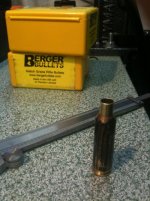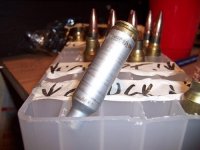C
chappo555
Guest
SOLVED -bumped shoulder cases wont chamber?
Righto heres the problem.
I have just purchased a Stolle Grizzly II with a Krieger 6.5*47 Lapua .292 nk barrel used but only 850 rounds fired.
I got 200 Lapua cases that have had 4 firings each. The previous owner had used graphite as a case lube and the cases were filthy. I tumbled and ultrasonic cleaned them up and then neck sized using a redding type S match die with a .289 bushing.
I tested some empty neck sized cases in the action and bolt was firm but not tight to close. I then thought Id bump the shoulder using the Redding body die. I set the die up with 40 thou clearance between the bottom of the die and the shell holder and sized two cases.
I then attempted to chamber these cases and they would not chamber at all. You would need two hands on the bolt to close it up.
Now ive checked the chamber and its free of obstructions. No marks on chambered cases either. I then measured some necked cases compared to the two ive FLS/Body sized.
NK / Body sized
Neck outside diametre .289 / .289
Web of case .471 / .471
overall length 1.8474 / .1.8470
Max overall length for 6.5*47 Lapua is listed as 1.854.
Based on these measurements I cannot understand how a FLS/body sized case will not chamber but a NK sized one will.
Have I missed something simple or are there strange forces at work well beyond my simple brain ?
All help and suggestions appreciated.
Cheers and thanks in advance
Chappo555
Righto heres the problem.
I have just purchased a Stolle Grizzly II with a Krieger 6.5*47 Lapua .292 nk barrel used but only 850 rounds fired.
I got 200 Lapua cases that have had 4 firings each. The previous owner had used graphite as a case lube and the cases were filthy. I tumbled and ultrasonic cleaned them up and then neck sized using a redding type S match die with a .289 bushing.
I tested some empty neck sized cases in the action and bolt was firm but not tight to close. I then thought Id bump the shoulder using the Redding body die. I set the die up with 40 thou clearance between the bottom of the die and the shell holder and sized two cases.
I then attempted to chamber these cases and they would not chamber at all. You would need two hands on the bolt to close it up.
Now ive checked the chamber and its free of obstructions. No marks on chambered cases either. I then measured some necked cases compared to the two ive FLS/Body sized.
NK / Body sized
Neck outside diametre .289 / .289
Web of case .471 / .471
overall length 1.8474 / .1.8470
Max overall length for 6.5*47 Lapua is listed as 1.854.
Based on these measurements I cannot understand how a FLS/body sized case will not chamber but a NK sized one will.
Have I missed something simple or are there strange forces at work well beyond my simple brain ?
All help and suggestions appreciated.
Cheers and thanks in advance
Chappo555
Last edited by a moderator:



